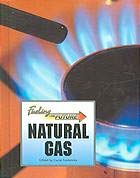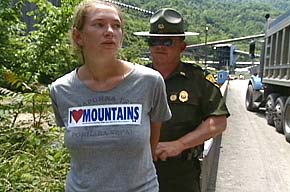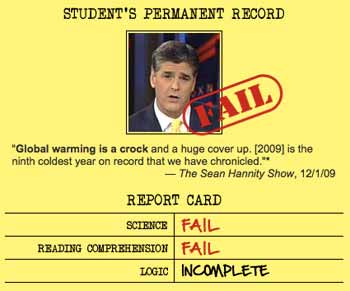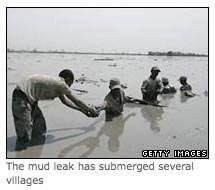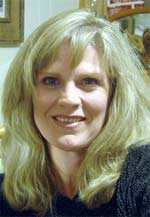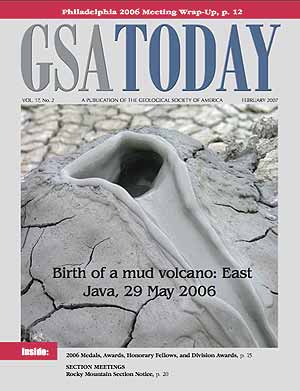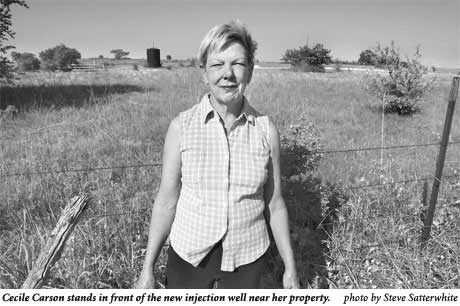Biblio
U.S. Senate. Committee on Environment and Public Works. Health Risks to Children and Communities From Recent EPA Proposals and Decisions on Air and Water Quality.
Submitted in Writing to Hearings before the Committee on Environment and Public Works,on February 6, 2007. Statement of Gina M. Solomon, M.D., M.P.H., Senior Scientist Natural Resources Defense Council, Associate Clinical Professor of Medicine University of California, San Francisco. 19 pages.
"Unfortunately, EPA is taking several major steps to eliminate information and decrease health protection from environmental hazards. Six recent draft or final EPA rules will each significantly limit critical information available to scientists, health care providers, communities, and ironically to EPA itself. As a result, children and communities will be left less protected and less able to protect themselves."
Using the latest in satellite imagery, aerial photography, and Google Earth technology, this ten minute SkyTruth video explores the environmental impacts of gas and oil drilling in the Upper Green River Valley, an ecologically sensitve area of western Wyoming.
See the view of the Upper Green Valley in Wyoming from the air and the effect of hundreds of gas drilling well pads. According to SkyTruth, 10,000 well pads have been proposed.
Michael C. O'Connell reveals how strip-mining in West Virginia is impacting local communities in the heart of coal-mining country.
While the demolition of the ancient mountain tops alters the state's natural landscape, the transportation of the mountain debris to adjacent valleys is creeping into natural resources used by area residents.
Filmed over a two-year period, Mountain Top Removal features citizen activists, such as Ed Wiley, Larry Gibson, Julia Bonds, Maria Gunnoe, and Mountain Justice Summer volunteers, in their efforts to stop the destruction of Southern Appalachia's natural landscape.
The film also includes commentary from Jeff Goodell, author of Big Coal: The Dirty Secret Behind America's Energy Future, geologists Dr. William Schlesinger and Dr. Peter Taft from Duke University's Nicholas School of the Environment and Earth Sciences, and also Bill Raney, President of the West Virginia Coal Association.
See: Mike Roselle clip 2-from the Southern Regional Jail West Virginia
See: Code Black: Coal’s Assault on America’s Health Campaign | PSR
See: Marsh Fork Elementary: Journey Up Coal River | A Community and Strip Mining
1976 video clip of M King Hubbert speaking about world oil depletion and explaining the concept of peak oil.
See article on the Energy Policy Act (2005).
Tempers and dangers are ramping up in the gas field we call home.
"Ah, for the good old days in the springtime of the Barnett Shale boom, when the words “royalty check” were enough to get homeowners to sign away their mineral rights and everyone still thought the 3 a.m. screech of drilling equipment was just the sound of money.
When no one thought that wells could possibly send property values tumbling or turn well water brown, before drilling sites and pipelines had started leaking, burping, and blowing up. When there were no neighborhood groups ganging up to demand higher royalties, tighter controls, or — say it ain’t so — trying to stop wells outright...
...Even gas company officials admit that the boom is drawing more and more inexperienced workers to drilling sites. “Veteran crews are being divided up and filled with people who have no experience whatsoever working rigs, laying pipe, and such,” said pipeline company manager Jerry Holsworth.
And so accidents are increasing. At least two people have been killed in Barnett Shale operations thus far.
Exxon Confronts Nuns, Calpers Over Global Warming Plans, Boskin
Exxon Mobil Corp., the world's largest oil company, faces growing criticism from investors who say it's lagging behind competitors in addressing global warming.
The Sisters of Saint Dominic, a Roman Catholic order in New Jersey, want shareholders at today's annual meeting to approve a proposal for setting targets on greenhouse-gas reductions. The California Public Employees' Retirement System, the biggest U.S. public pension fund, seeks to oust Michael Boskin, the Exxon director who runs the board committee responsible for environmental issues.
...``Exxon's the industry laggard when it comes to climate change,'' said Laura Shaffer, manager of shareholder activities at the New York-based Nathan Cummings Foundation, which oversees $535 million.
``Given their market capitalization and their earnings, they shouldn't be lagging anybody on this issue.''
The foundation is part of an investor group that backs a proposal to force Exxon to boost spending on ethanol and other non-petroleum fuels.
Shareholders who attend the meeting at the Symphony Center in Dallas will also vote on a measure that seeks to rein in share buybacks, which have tripled in the past three years, in favor of a one-time dividend. Another would limit compensation for the company's top five executives, including Tillerson, to $500,000 a year.
When an EPA study concluding that hydraulic fracturing "poses little or no threat" to drinking water supplies was published in 2004, several EPA scientists challenged the study's methodology and questioned the impartiality of the expert panel that reviewed its findings.
See: Halliburton's Interests Assisted by White House - Los Angeles Times.
See: The American Association for the Advancement of Science (AAAS) Reaffirms Statements on Climate Change and Integrity. 12/04/09.
Sean Hannity of Fox News has failed Science.
Can you tell Fact from Science Fiction?
BBC. January 24, 2007. A mud flow that has displaced thousands of Indonesians was most probably caused by gas drilling, scientists say.
See: Davies, R. J, R. E Swarbrick, R. J Evans, and M. Huuse. 2007. "Birth of a mud volcano: East Java, 29 May 2006." GSA Today 17, no. 2: 4–9.
See below: Hardiyan Digwiyono. (2006). "Children in the Hot Mud Volcanoes". YouTube.
Watch the related videos that follow this one minute film.
Most Texans don’t know what the Texas Railroad Commission is or does. In 2007, one Texas blogger changed that: Sharon Wilson. Wilson’s reporting on the injection well drilling in the Barnett Shale region and its impact on the water quality and the environment in Wise County and surrounding areas has been exceedingly important to bringing wider attention to the dangers this practice poses across the state.
Wilson has nearly single-handedly stood up to large oil companies and made the companies and state agencies–including the Texas Railroad Commission–take notice. Relentless in her drive to educate the public and elected officials to the damage being done to the Texas environment, Wilson’s investigative reporting and blogging is worthy of recognition.
Abstract
On 29 May 2006, an eruption of steam, water, and, subsequently, mud occurred in eastern Java in a location where none had been previously documented.
This “pioneer” mud eruption (the first to occur at this site) appears to have been triggered by drilling of overpressured porous and permeable limestones at depths of ~2830 m below the surface.
We propose that the borehole provided a pressure connection between the aquifers in the limestones and overpressured mud in overlying units.
As this was not protected by steel casing, the pressure induced hydraulic fracturing, and fractures propagated to the surface, where pore fluid and some entrained sediment started to erupt.
Flow rates remain high (7000–150,000 m3 per day OR 1,849,204 gallons to 22,500,000,000 gallons per day) after 173 days of continuous eruption (at the time of this writing), indicating that the aquifer volume is probably significant. A continued jet of fluid, driven by this aquifer pressure, has caused erosion and entrainment of the overpressured mud.
As a result, we predict a caldera will form around the main vent with gentle sag-like subsidence of the region covered by the mud flow and surrounding areas. The eruption demonstrates that mud volcanoes can be initiated by fracture propagation through significant thicknesses of overburden and shows that the mud and fluid need not have previously coexisted, but can be “mixed” within unlithified sedimentary strata.
See: Wikipedia | Sidoarjo mud flow
In February 2010, a group led by experts from Britain's Durham University said new clues bolstered suspicions the catastrophe was caused by human error. In the peer-reviewed journal, Marine and Petroleum Geology, Professor Richard Davies, of the Centre for Research into Earth Energy Systems (CeREES), said that drillers, looking for gas nearby, had made a series of mistakes.
They had overestimated the pressure the well could tolerate, and had not placed protective casing around a section of open well. Then, after failing to find any gas, they hauled the drill out while the hole was extremely unstable. By withdrawing the drill, they exposed the wellhole to a "kick" from pressurised water and gas from surrounding rock formations. The result was a volcano-like inflow that the drillers tried in vain to stop.
In the same Marine and Petroleum Geology journal, the group of geologists and drilling engineers refuted the allegation showing that the “kick” maximum pressure were too low to fracture the rock formation.
The well pressure analysis based on credible data showed that the well is stronger than the maximum pressure exerted on the well. This implied that the hydro fracturing hypothesis is likely to be incorrect.
See: BBC News. 2007. "Drilling blamed for Java mud leak." BBC News | Asia-Pacific. January 24.
See: Alexis Madrigal. 2010. "Mud Volcano Was Man-Made, New Evidence Confirms". Wired | Science. February 11.
Sawolo, N., E. Sutriono, B. P Istadi, and A. B Darmoyo. 2009. "The LUSI mud volcano triggering controversy: Was it caused by drilling?" Marine and Petroleum Geology 26, no. 9: 1766–1784.
See: Sawolo, N., Sutriono, E., Istadi, B., Darmoyo, A.B. (2010). "Was LUSI caused by drilling? – Authors reply to discussion". Marine & Petroleum Geology 27:1658–1675.
Cecile Carson's property has an aura of rural homeyness. The neat yard, happy dogs, and blooming flowers along her fence rails suggest a love of place.
She's a high school art teacher who picked a little swath of Wise County near the small town of Decatur, about 35 miles north of Fort Worth, to settle down. She lived in a travel trailer for the first three years while she designed and built her home. The place is well thought out—its colors blend with the surrounding landscape of green, rolling hills.
It took Carson 10 years to get to this point. But it took the Railroad Commission of Texas about 45 seconds to put it all in jeopardy. On April 11, at an administrative hearing in Austin, it took less than a minute for a public reading of Carson's and her neighbor's protests against the placement of an oilfield waste injection well just a few hundred feet from their property.
Then the three commissioners immediately voted "denied" without discussion...
...Part of the commission's enforcement problem is a lack of effective penalties. After the commission field staff goes through an elaborate protocol of voluntary compliance with an offending operator, the inspector must dot every "i" and cross every "t" in order to file a legal enforcement package that will, at most, result in a fine of between $500 and $3,500.
Jim Robbins. September 10, 2006. New York Times.
It is a strange fight, Montana ranchers say. Raising cattle here in the parched American outback of eastern Montana and Wyoming has always been a battle to find enough water.
Now there is more than enough water, but the wrong kind, they say, and they are fighting to keep it out of the river.
Mark Fix is a family rancher whose cattle operation depends on water from the Tongue River. Mr. Fix diverts about 2,000 gallons per minute of clear water in the summer to transform a dry river bottom into several emerald green fields of alfalfa, an oasis on dry rangeland. Three crops of hay each year enable him to cut it, bale it and feed it to his cattle during the long winter.
“Water means a guaranteed hay crop,” Mr. Fix said.
But the search for a type of natural gas called coal bed methane has come to this part of the world in a big way. The gas is found in subterranean coal, and companies are pumping water out of the coal and stripping the gas mixed with it. Once the gas is out, the huge volumes of water become waste in a region that gets less than 12 inches of rain a year.
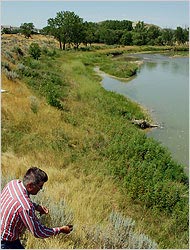
Mark Fix, a cattle rancher in eastern Montana, diverts about 2,000 gallons per minute of Tongue River water in the summer to grow hay for his livestock. But increased sodium in the water could endanger his hayfields.
See: Molly Ivins. (2004) C-Span Book TV Oct. 2, 2004. Bushwacked: Life in George W. Bush's America. Chapter: "Dick, Dubya, and Wyoming Methane." (152)
U. S. EPA Office of Atmospheric Programs. (2006). Click on Executive Summary (PDF) (26 pp, 310K).
Provides a broad overview of all U.S. greenhouse gas emission sources and sinks, introduces key concepts and discusses the primary drivers for changes in emissions, which has resulted in global warming.
See: Global Warming Frequently Asked Questions
Greenhouse gases Carbon Dioxide (CO2) and Methane (CH4) taken together account for 93% of all emissions, with 85% for (CO2) and 8% for (CH4). Enteric fermentation (flatulence and belching), taking place as a digestive by-product of cows and other ruminant animals accounts for less than half of the Methane emissions. Coal mining and natural gas systems, in addition to the (CO2) emissions of vehicles used to transport water add significantly to the total of all greenhouse gas emissions.
For pie charts graphically showing these percentages, see pages 20-22.
A television commercial about global warming from Environmental Defense and the Ad Council.








